Letchworth State Park waterfalls at half speed
Same video at half speed. More relaxing.

Same video at half speed. More relaxing.
My dad, persistently frustrated by cheap cameras, would be amazed by what you can do with something that fits into your pocket. He would be more amazed and likely appalled by how much such a thing costs. I know he’d envy my photos and videos of Letchworth, though. From late May 2015.
Facebook has many flaws, but it does alert me when events I might be interested in are coming up. A few weeks ago I found out about the world premiere of Octave Chanute: Patron Saint of Flight, at Indiana Dunes Visitor Center. I knew the Chanute name vaguely from the old Air Force base, but I couldn’t have told you then where the base had been located or why it was named Chanute. This sounded like a way to get in a visit to Indiana Dunes, learn something, and spend what might be otherwise a dull winter afternoon, depending on the weather.
The parking lot was unusually crowded, and when J and I walked in about a half hour early, a good-sized group was watching Shifting Sands: On the Path to Sustainability, a documentary on the history of Indiana Dunes and efforts to restore what can be restored. It’s meant to inspire, but it’s also tragic and depressing.
By the time Shifting Sands ended and Octave Chanute was scheduled to begin, the auditorium had filled up, even when extra folding chairs were brought out. Soon it was standing room only.
Simine Short, author of Locomotive to Aeromotive: Octave Chanute and the Transportation Revolution, and young director Paul Nelson introduced the film. I mention Nelson’s relative age because the audience was mostly 50 plus, possibly 60 plus, which disappointed me because I would like to see younger people interested in history. Of course, when I was younger none of my peers would have been interested, either.
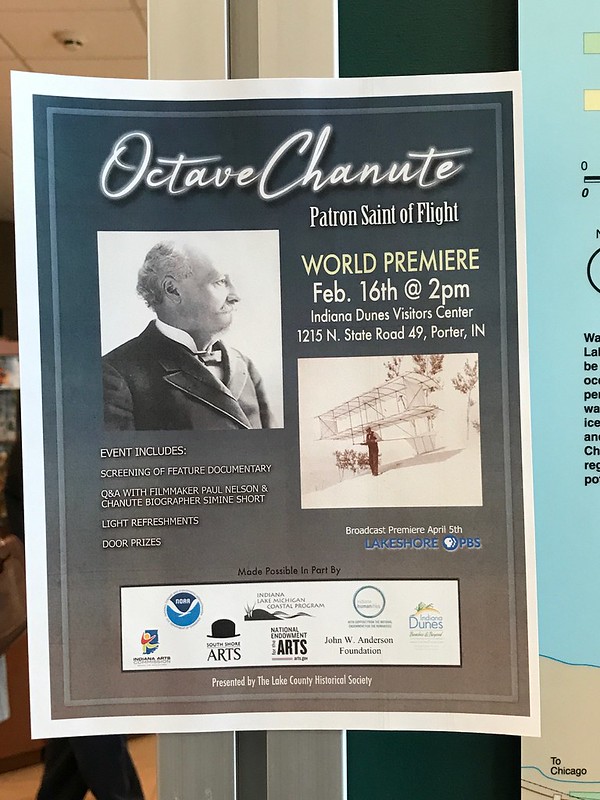
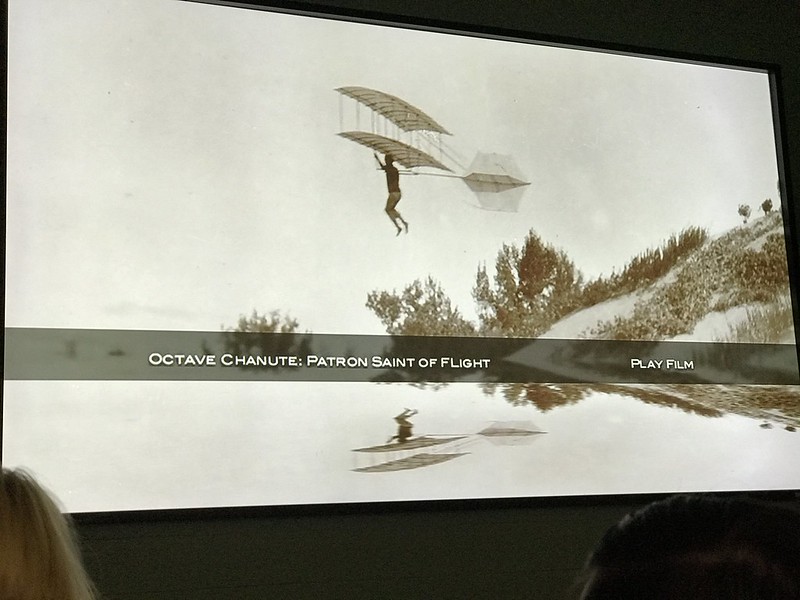
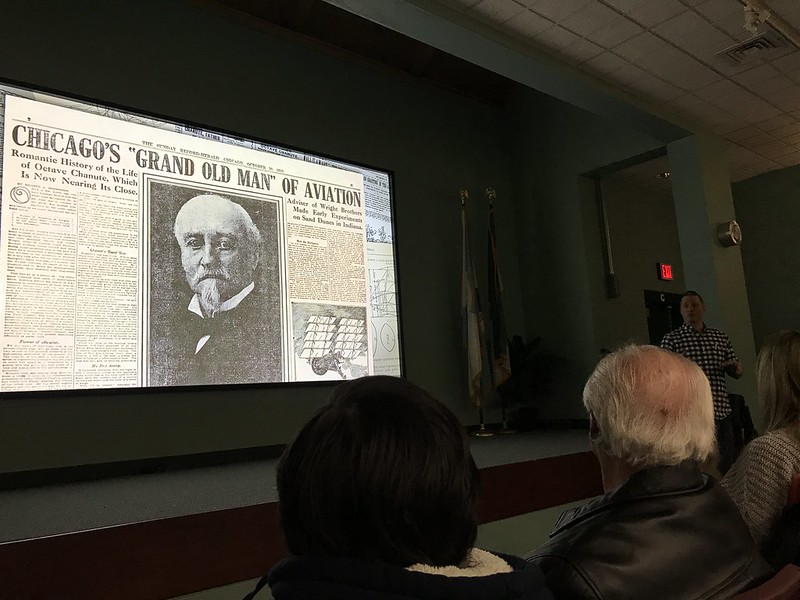
The presentation began with some technical glitches (flashbacks to every high school A/V club everywhere!), but my ears perked up at the mention of the Portage Bridge, accompanied by a photo I recognized immediately. Through this film, I found out Octave Chanute was the engineer behind the much-loved railroad bridge over the Genesee River at Letchworth State Park in New York.
Known for his bridges, Chanute was called in when the original timber trestle, the longest and tallest wooden bridge in the world when it opened in 1852, was reduced to ashes on May 6, 1875, after a train had passed over (spark?). Chanute’s iron replacement opened only 86 days after the fire. According to Short’s book, the piers were rebuilt and the uprights and girders strengthened in 1880, “making the bridge better than new.”

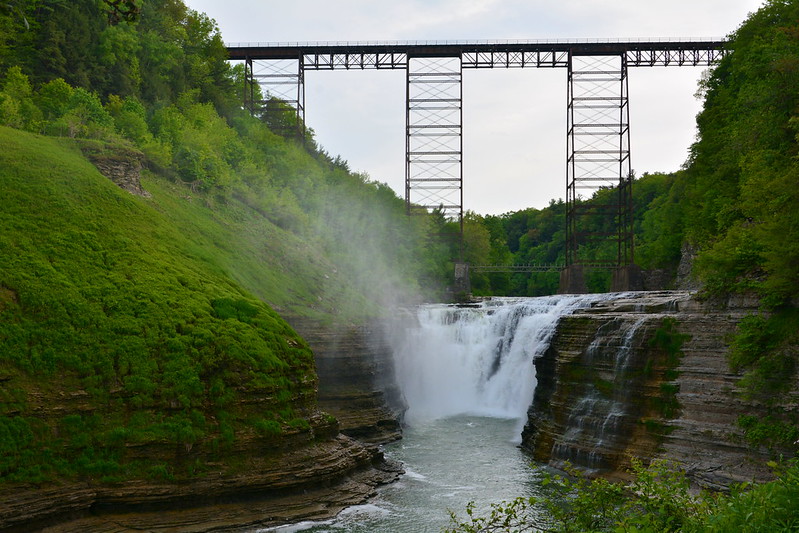

Although modern Norfolk Southern trains were restricted to 10 miles per hour over the Letchworth gorge, Chanute’s bridge lasted until 2017, when the Genesee Arch Bridge opened. The state of New York declined the offer of the 1875 bridge, the last of which was demolished on March 20, 2018. I’d been fortunate to visit the old bridge one last time in 2015. When I’d found out about the premiere of this film, I’d had no idea it would take me back to perhaps the most iconic of my childhood memories. I remember walking along those tracks with my brother during one of his visits.
But wait! There’s more!
My ears perked up again at the mention of Kinzua Bridge. I’d found out about Kinzua Bridge State Park when I was looking up Kinzua Dam, another place I’d visited as a child, for my 2015 swing through Ohio, New York, and Pennsylvania.
It turns out that Octave Chanute was behind the original 2,000-foot-long Kinzua Bridge (or Viaduct), built in 1882 at 302 feet above the narrow valley floor. Short calls it Chanute’s “most spectacular bridge.” She adds that the bridge was rebuilt in 1900 “to keep up with the increasing volume and weight of the coal traffic.” Carl W. Buchholz redesigned the superstructure on the original masonry foundation piers.
By 1959 the viaduct failed safety inspections and was closed to commercial rail traffic. Restoration began in 2002, but in 2003 an F2 tornado “tore eleven towers from their concrete bases. Investigators found that the anchor bolts, installed under Chanute’s supervision, had rusted over the past 120 years.” Over time, the materials had failed the design.
After seeing this film, I’m even happier that I had the opportunity to walk out on what’s still standing of Kinzua Bridge and get a look at the remnants resting in peace on the valley floor. Even destroyed, Kinzua Bridge is indeed a “spectacular” sight.
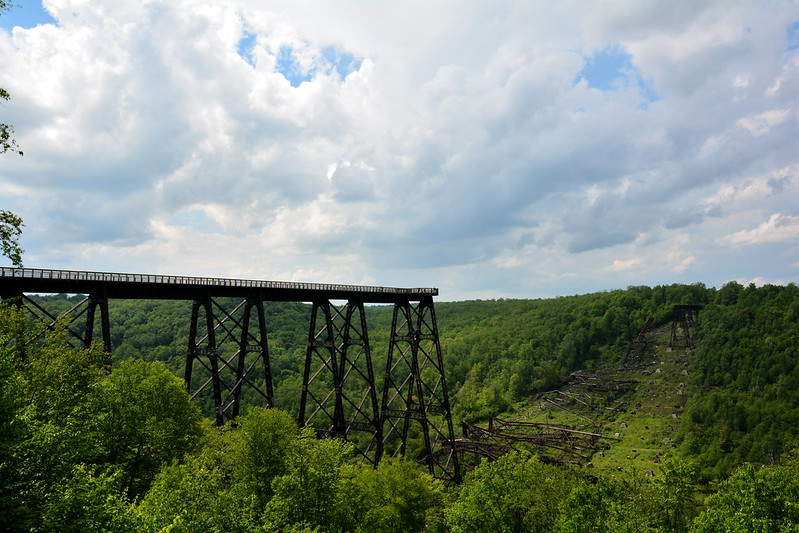
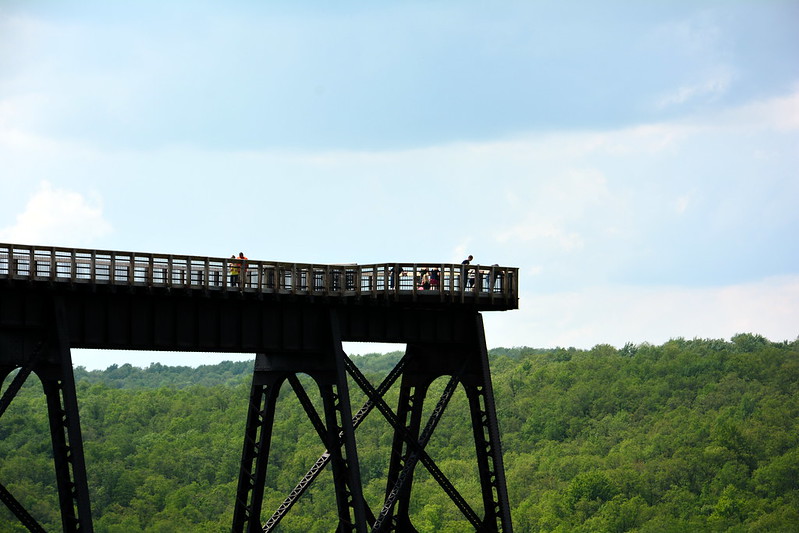


Of course, most of the film was about Chanute’s contributions to flight and relationship with Wilbur Wright (rocky; Chanute was an open source kind of man and Wilbur believed in closely held information). What’s the link to Indiana Dunes? With their lake winds, elevations, and soft sand, the Dunes were Chanute’s choice for safely testing their experiments — the Kitty Hawk of the Midwest.
Octave Grill in Chesterton is named for Octave Chanute. Found out they serve a Chanute burger.

I started the morning out with a bang by falling hard in the Jacuzzi bath that I’d enjoyed so much — I knew I’d brought those spa shoes with treads along for a reason.
As this was the last day at Temple Hill, our host gave us a peek at the pool and garden area, complete with a Japanese tea house under renovation.
After saying goodbye, we took ourselves to a nearby laundromat to freshen the wardrobe and killed the waiting time by going to Wegman’s, a favorite of some of my friends (who wouldn’t love a place that carries Uncle Ralph’s Magic Sauce?) and Yoberry Yogurt. After the laundromat we made what I was sure was our final stop at a Tim Horton’s.
Temple Hill is across the road from an old cemetery that is still in use, so we walked through for a bit, long enough for me to spot the grave of a former New York governor. I also found a child’s grave marked by a flat, broken, worn tombstone at the base of a tree, half covered by dirt. Others had fallen over and broken. Earth to earth, ashes to ashes, dust to dust indeed.
This time we didn’t go through Letchworth but along its western edge. We spied a place where it looked like maple syrup might be available, but when we went in, we found a very musty old barn that seemed to be a half-abandoned disordered mess. I imagine it’s haunted at night by wheezing asthmatic ghosts. No one at the nearby house came out, but a neighbor pulled into the driveway across the road and tried not to give us stink eye.
This time I went into the Glen Iris Inn gift shop, relieving them of more postcards than was necessary, then we explored the museum, which I remember vaguely.
Although it was a little out of the way, I had J. return to the Wolf Creek picnic area so I could regret leaving it a second time, this one for good.
We settled in at the Glen Iris Inn for a leisurely dinner followed by farewell visits to the Middle Falls and the old railroad trestle, around which ground has been cleared of trees for construction of the new bridge.
Reluctantly, as always, we turned southward toward Coudersport, Pennsylvania, and Frosty Hollow Bed and Breakfast. Along the way we stopped at a grocery store where I asked one of the shoppers the way to the facilities. She pointed toward the back to my right, but a few moments later ran after me and said she was wrong; it’s near the deli. I couldn’t find it there, so I asked a woman working there. Next thing I knew, she was leading me into the “back of the house” to the room the employees use. I thanked her, adding that I could never have found it on my own. She smiled brightly, saying, “Always ask an employee!” I began to feel like I was in a disjointed dream.
When we passed through Belmont, J. asked me to make a note — he liked it. Small-town New York retains a certain quaint vintage look that, if it ever existed in Chicago, was likely destroyed by the Great Fire and suburbanization. We crossed back into Pennsylvania, passed through Coudersport, and arrived at Frosty Hollow Bed and Breakfast at around 10 p.m. for the final leg of this eastern adventure. We were in the Pennsylvania Wilds.
A moment of serenity and bliss at Wolf Creek at Letchworth State Park in western New York.
Because we were the only guests at Temple Hill Bed and Breakfast, we were treated to breakfast al fresco on the deck overlooking the back lawn. It was so perfect that I hated to leave. We had to get an eyeglass repair kit (can’t have a driver who can’t see), then stopped at Byrne Dairy for me to look around and then Cricket’s Coffee Company because neither of us can resist a good coffee shop. We scored some condiments, including mustard and nut butters.
Eventually we tore ourselves away to return to the park, where we stopped at several of the overlooks. At one I read a sign pointing out a barely visible waterfall below and noting that another of four waterfalls could be seen at the Wolf Creek Picnic Area, so we had to go there too. From a pedestrian bridge over Wolf Creek, you can see a series of teeny drops along the creek bed, like miniature Niagaras, with the road bridge in the background. In an instant Wolf Creek evoked memories of sunbeams interrupted by shadows playing over rocks and drops as I walked along the creek bed without a care at Chestnut Ridge Park during a church picnic. Wolf Creek became a surrogate for one of the richest of my childhood experiences.
The real waterfall, the most visible of the series mentioned on the sign, drops on the other side of the pedestrian bridge. I don’t remember seeing Wolf Creek with my parents, but then there is so much that I don’t recall.
J. satisfied some of his shopping urges at the Glen Iris Inn, where we spent a long time taking photographs of the Middle Falls, which many believe are the most scenic of the park’s three major waterfalls. It’s funny that I recall the falls, but not the inn. I am sure that one day Virgil and I and possibly my aunt walked along the rail line if not part of the trestle.
Instead of driving back through the park as we had the day before, we passed along its eastern edge, where the roadside sported horse-and-buggy signs indicating that it’s Amish country. It’s a lovely rural drive and on this day the robin’s egg blue sky was punctuated by amazing clouds that I couldn’t quite capture.
Our destination was the North Shore Grill on Lake Conesus in Lakeville, giving us an opportunity to see one of the Finger Lakes (if only the smallest). There’s nothing like enjoying a great meal and drinks outdoors on a lake shore around sunset. I walked to the end of the dock to take all of it in — if only I could take all of it with me.
After another sumptuous breakfast, we left for Letchworth State Park, which has a fascinating history that includes the abducted Mary Jemison and business mogul William Pryor Letchworth. It’s amazing to me to imagine places like Matthiessen State Park (Illinois), Morton Arboretum (Illinois), and Letchworth State Park (New York) in private hands. Can you picture waking up every morning and strolling to your private waterfalls and/or along your stretch of a river?
First we stopped at Mount Morris Dam and one of the gifts shops, where I spent an alarming amount on books and postcards. They even have the vintage-looking wooden postcards, which can be mailed for extra postage. We sat in the picnic area to try a treat and just to soak in the day. When New York weather is good, it’s wonderful.
I remember Mount Morris Dam vaguely. It looked dry around it. In 1972, Hurricane Agnes dumped a massive volume of rain on Pennsylvania and western New York — that’s when I learned hurricanes from the south could affect us so far inland. Mount Morris Dam, completed in 1954, was pushed beyond its limits (some water was released to avoid the river pouring over the top), but without it much of Rochester may have ended up flooded (or in Lake Ontario?).
We continued driving south through the park, stopping at the Gardeau Overlook and at the Lower Falls Restaurant for a leisurely, relaxing lunch.
Next we tackled the Lower Falls Trail, which is supposed to have 127 steps, although some people who were returning told us they’d counted at least 128. I can’t say an extra step makes a difference unless it’s exceptionally steep (a couple were). I can manage, albeit slowly and sometimes with a helping wrist.
Of the three major waterfalls on the Genesee at Letchworth, the Lower Falls are said to be the least scenic. You can cross a bridge over the river to get a better look at the falls and Tea Table Rock, which some people walked onto. On the other side, water drips down from the rocks with slippery mud underneath, making it a great place to stand on a warm day. J. went a little past the bridge, but I was trying to save my energy for the walk back and my knees for the 127/128/1XX steps up. I haven’t looked up how far the trail goes, but with more time and energy I imagine we could have seen much more. I can’t say for sure that I’d ever seen the Lower Falls or been to the restaurant before — perhaps, perhaps not.
At Inspiration Point, the views of the gorge are especially spectacular. Fortunately for us, William Pryor Letchworth was a generous man with foresight who wanted to preserve the gorge from a particularly grisly future subject to the whims of industry, economics, and greed. I’ll have to read more about the history of Letchworth in the books I spent my vacation money on.
J. also got his first look at the Upper Falls with the railroad trestle passing above them. This bridge, in place since 1875, is being replaced by an updated design that won’t have piers in the gorge. I’m glad I could see the old bridge one more time and now wish I’d walked it. I am sure my brother and I walked along part of it once, long ago on a beautiful day, surrounded by trees, sun, and shadows.
As it was Memorial Day, little was still open by the time we were ready to eat, so we went to Mama Mia in downtown Geneseo for doughy, cheesy food right before the rain that had been threatening finally let loose.
After a leisurely breakfast and some moments in the sunroom overlooking the lake and the wind turbines, we packed and, after the now-traditional stop at Tim Horton’s, headed north on Route 5 to Old Fort Niagara. On Grand Island, we debated a detour to Beaver Island State Park, but there wasn’t enough time.
I’d been to Old Fort Niagara perhaps twice. Once a couple of my friends had come with us — I remember this because somewhere I have a closeup of our faces as we sat in the back seat of my dad’s van. Also among my photos there’s one of my dad and mom walking across a bridge or embankment in the middle distance. The enormous weight gain that had snuck up on him jutted out prominently, while a couple of yards behind him my mother struggled to keep her hair from blowing in the wind. It’s not a flattering photo, but I like it because it’s one of the few unposed photos I have of them together.
My dad may have taken me one more time, after my mother died and I had graduated from college. I can’t remember if we went to both Niagara Falls and Old Fort Niagara, or just Niagara Falls, but I recall eating lunch in a parking lot and feeling how odd and wrong it was to be on a little adventure without my mother.
When I’d been to Old Fort Niagara before, I’d been struck by the number of college-age boys dressed in redcoats, firing muskets and cannons — funny to think that, like me, those kids have aged into their fifties. On this day, the fort wasn’t overrun by college-age redcoats, but by characters of various ages from several wars and conflicts, from pre-Revolutionary War to the Korean War and beyond — in tribute to Memorial Day. It was a little disconcerting to see GIs at the old fort.
We listened to part of a long presentation about uniforms and the story of Betsy Doyle, who during the War of 1812 ran hot shot up the stairs of the fort’s French Castle. I struggled to get up the stairs even once without toting deadly hot shot.
I’m sure I saw a lot more of the fort on this day than I had before, but I’ve never seen as much as I could. It was a beautiful day, too, with a slightly hazy look that I associate with this area, located across from Canada at the mouth of the Niagara River. It truly feels like a place out of time.
On the return trip, i took a photo of what I’d always thought was a wrecked barge jutting up from the Niagara River north of the Peace Bridge, with trees thrusting through the deck. Since then I’ve read it’s an old water intake station. There go all my assumptions and memories, as I remember my dad pointing it out to me.
On our last pass down Route 5, we made a final stop at Red Top Hots, although it wasn’t quite the same without BL freezing in the lake breeze. After stopping at the house to say goodbye to BL and family, we picked up a perfect souvenir of western New York — Weber’s horseradish mustard, which I don’t remember from my childhood at all.
Next we hurried to Chestnut Ridge Park to find the eternal (not really — it gets blown out frequently but can be relit) flame waterfall. Google Maps seemed determined to send J’s car down a footpath through dense woods, but I wasn’t convinced. As we meandered around a bit, seeing lots of high schoolers in the backs of pickup trucks (which surprised me), finally we asked a man walking his dog where to go. It turns out there’s a parking area for the trail off 277 that was easy to find, but in the meantime we’d lost an hour or an hour and a half of daylight by the time we arrived at the trailhead. I wish I’d remembered my way around Chestnut Ridge! We did get a brief glimpse of the toboggan run . . .
The trail to the falls isn’t too rough, although it’s steep in places, with rocks and logs in the way along the creek. By this time, fatigue had set in from several days of walking and standing, and I couldn’t make it past an uneven part of the trail near the water, even as young people leapt past me and others walked by without a care. As J. continued on, several people offered to help me, but I was physically and psychologically stuck, deterred by what may seem to most to be a tiny obstacle, but it was too much for me at that point in time. J. did see the falls, which he said were farther off than he thought based on what people were telling him. Although there wasn’t a lot of water, the flame was lit. I wish I’d seen it.
We left for Geneseo at about 8:15 p.m., traveling through East Aurora, Warsaw, and Perry on Route 20A, all of which J. liked. One deer crossed the road, and J. spotted a second. Along the way we passed dozens of wind turbines, just like in parts of Illinois on our way back from the Illinois River Road. Route 20A is more twisty than most roads in Illinois, and J. found himself hard pressed to keep out of the way of impatient locals, pulling over when possible to let them pass. At last, shortly before 10 p.m., we arrived at Temple Hill Bed & Breakfast, to be greeted by our friendly host, her friendly dog, and welcome rest after an exhausting but exhilarating few days.
Intrigued by South Creek Road, J. and I set out before breakfast to drive down as much of it as we could. (I wasn’t looking at maps — no need to.) It ends in Eighteen-Mile Creek County Park, which as serves as a state-designated fishing hole. There’s not much of a conventional park here — just a gravel parking lot without even a portable john. A paved trail cuts into the woods, turning into a dirt trail with a side trail that looks like it goes down to the creek. We were going to be late for breakfast even if we hurried back (on the walk to the parking area, I got a friendly reminder call!), so we didn’t make it down. Later I read that Eighteen Mile Creek County Park is (take your pick) (1) abandoned (2) undeveloped. One website said there had been a proposal or plan to turn it into a golf course. No, no, no, a thousand times no . . . the same site also noted that the path we’d found doesn’t go to the creek, but one a tenth of a mile further on does. Reason to return . . . for now, it’s a relatively untamed spot that had drawn several cars to it by the time we left. Although the area is reverting to nature, J. found what to us appeared to be stone gateposts, with upper and lower hooks still attached. If I had known about this spot, I might have made an effort to go there. It would have been a strenuous ride up and down the mild inclines, though. Knowing me, I’d have flown over the rails into the creek. Four miles and twenty minutes to a bit of paradise — I could have managed it then and might even have appreciated it.
What’s a trip to western New York without a visit to Niagara Falls? I hadn’t been there since 1987, when I went late in the afternoon on a dreary day of threatening weather. Today was sunny and getting warmer by the minute, as we’d found on our morning walk. After a luxurious breakfast we left, making a stop at one of the Tim Horton’s along the way. With the help of Google Maps, I steered J. wrong briefly while in Buffalo, but soon we were back en route, and I was seeing familiar sights like the Pillsbury building, the Tifft Nature Preserve (which I’ve never visited), and the Peace Bridge.
Then we came to Grand Island, where the imposing bridges have been painted a blue that almost blends into the sky. The geography, which I’m sure I never understood, was coming back to me. I remember once or twice taking a more scenic route to Niagara Falls, but my guess is that it may have involved crossing the Peace Bridge and driving along the Canadian bank of the Niagara River.
I’d failed to take into account one important detail — with Memorial Day on Monday, the area was crowded with traffic and people, probably more so than usual. Someone in a hurry even managed to take a paint chip off the back on the driver’s side (as often happens, it didn’t register until later, but he heard and felt it). We found ourselves in a distant parking lot, waiting for a shuttle to take us closer to Goat Island. I don’t remember that at all from years ago, but while the populations of Buffalo and Niagara Falls have declined, the number of tourists who want to see this attraction seems to have expanded exponentially.
In my 18 years in New York, I’d never gone aboard any of the Maid of the Mist boats. From what I can recall from my brain’s faulty data banks dating to the 1960s and 1970s, the Maid of the Mist was a popular, modestly scaled service, but today it’s a big operation that moves people with the precision of a factory conveyor belt. I told J. that the people ahead of us disappearing into the bowels of the next Maid in line were destined for some hideous end (Soylent Green?), never to be seen again (the people visible on deck could simply be a regular cast planted there to make you feel complacent). As it turns out, the scale wasn’t my imagination or a distorted childhood memory — the boats I would have seen when I was, say, five years old carried about 100 people, while today’s Maid has a capacity of 600. I wish I’d had a chance to take the trip as a child, even without an iPhone or Nikon to record it.
As an aside, operations on the Canadian side are run by a different company, so when you look down you’ll see a boat loaded with blue ponchos (American side) and a boat loaded with (maple leaf) red ponchos (Canadian side). Rival rain gear!
After passing through the pre-boarding points of the Maid of the Mist experience with assembly-line efficiency, we picked up our own blue ponchos from a giant shed and were shepherded on board, where we found a good spot with a view, not too many heads in front of us, and a bar to cling to. The ponchos are effective at keeping out the spray from the falls — my arm got wet mostly because water ran down the sleeve as I held onto the vertical bar.
The Maid of the Mist stops at the more attractive Horseshoe Falls first, lingering long enough for us to appreciate the beauty and power of the water and its deafening roar. I’m still amazed a boat can approach so closely, to be swallowed by the mist. My dad, more knowledgeable than I, used to find my fear that it would capsize amusing. Today the boat stayed in place seemingly effortlessly as I struggled to take photos while trying to keep the iPhone and camera dry.
Next the Maid swings back toward the American Falls, where the remnants of several rock slides prevent too close an approach and there’s less mist further out to obscure photos. I’d rarely been to Niagara Falls on such a sunny day, when even the lines of the water looked crisp in the bright light.
After leaving the Maid, we spent a long time in the observation area, which has magnificent views. Although I tried, it was hard for me to imagine the real “Niagara Frontier” the way the first people in the area had seen it. (I can’t picture the abomination of the Niagara Mill District, either, even after seeing vintage photos of it.)
By now I was getting tired, it was late in the afternoon, and we needed to get back to pick up my cousin and his wife for dinner, so we skipped Old Fort Niagara when I realized how far away it was and turned south toward Grand Island and the B&B for a brief cleanup and rest stop.
Next we headed into Hamburg and through Water Valley toward Eden. I can’t explain it, but I love the drive through Water Valley, which is little more than a bridge over a dip in the landscape where the creek runs. I always felt like I’d been transported instantly and magically from town to country, from present to a recent past. Past Water Valley, Braymiller’s Market, where we used to stop for ice cream or custard, is still there, looking unchanged.
For a short time there was a European cheese store on Route 62, where my dad willingly stopped so I could buy cheeses and a powdered Swiss drink that came in a jar with a red label and lid and had a robust flavor like a grain. I can’t remember the name anymore, even after I found it once or twice at the old Chalet in Hyde Park.
The shop looked quaintly European to my young mind, and I loved the cool atmosphere inside, dim after the brightness of the outdoors. I was heartbroken when one day we stopped to find it closed — no yelp.com then to warn us of these things. The building is still there, housing a Subway sandwich shop complete with the original Swiss-themed exterior artwork. As of June 2015, the franchise is up for sale for the reduced price of $55,000. How interested am I in franchising?
After dinner at Pegasus in Hamburg, we took my cousin and his wife home, where we visited for a couple of hours. I learned some new stories about both my dad and cousin. He told me the union had leased their hall next to Tony’s (formerly Jim’s) because they didn’t need that big of a space. I said Ford seems to be doing well and keeps its buildings well maintained, unlike some of the rusty plants in south Buffalo (and survived, unlike its neighbor, Bethlehem Steel). He noted, however, that in its heyday the Ford Stamping Plant had up to 5,000 employees, while now it has perhaps 700. It’s no wonder they don’t need that big union hall. He also mentioned what a fabulous place Old Fort Niagara is with all its history, which cemented the idea of going there. After taking a couple of photos and bidding them a very reluctant farewell after 11, we returned to the B&B, which we still couldn’t find in the dark!